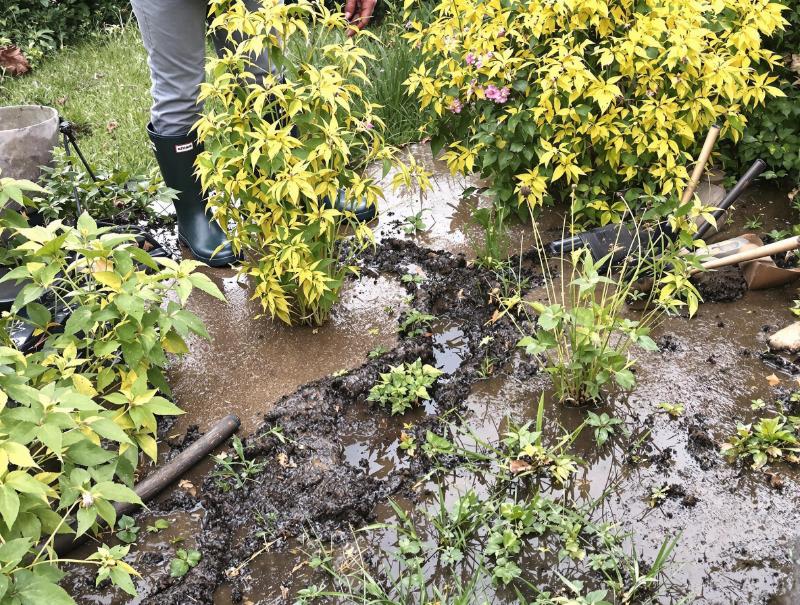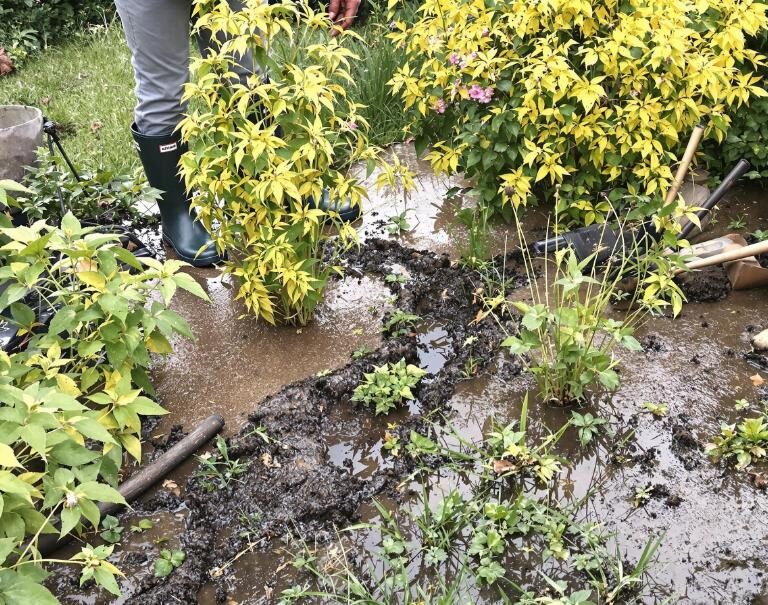Good water control separates thriving gardens from struggling ones. Too much water causes slippery spots, root rot, and pest issues.
Leave these problems unfixed, and your once-beautiful yard can turn into a mess pretty quickly. Keep reading to learn how to spot and fix water problems before they get out of hand.
Causes and Effects of Poor Water Circulation
Inadequate water flow mainly affects soil consistency and oxygen supply to roots. These conditions seriously impact plant health and, over time, reduce the nutrient-holding capacity of the area.
The result? Infestations, mildew infection, patchy growth, and inedible harvests.
Multiple factors contribute to these challenges. Soil composition has a significant impact. Dense clay restricts moisture movement more than other types, like loam, for example.
Your landscape’s layout also matters. Level areas tend to experience water accumulation, whereas slopes direct runoff toward unintended sections. Even hardscaped areas with walkways and patios influence moisture distribution if poorly designed.
Recognising Signs of Inadequate Drainage
Water pools and muddy patches clearly indicate a problem. The sooner you spot these troubling signs, the better.
Look for lingering moisture or mucky areas after rainfall. You need to identify potential issues early. Check your landscape regularly and note any soggy sections that persist, even during warm and sunny weather.
Document your observations in a dedicated journal or app. Highlight dates, locations, and suspected causes of accumulated wetness. This helps pinpoint the main reason behind the issue so you can address it permanently.
Conducting a Percolation Test
To check your garden‘s absorption capability, dig a hole 30 cm deep and 15 cm wide, fill it with water, and monitor drainage. Keep a stopwatch nearby to measure how long complete absorption takes.
This process should require approximately 60 minutes. Longer periods suggest your terrain could benefit from additional assistance.
Perform this assessment in different sections, especially where liquid tends to stagnate, then compare results. This identifies trouble spots and evaluates your garden’s overall moisture management capacity.
Record findings, including absorption time and notable soil characteristics. This information determines if intervention is necessary to prevent waterlogging.
Evaluating Soil Type
The ground’s composition affects your garden’s water consumption. Substrates with large particles, like sand, effectively facilitate moisture flow. Sandy soil drains quickly – great for preventing puddles, but your plants can get thirsty too fast.
Clay soil is the opposite. It holds onto water like a sponge, often making things too wet. Loamy soil hits the sweet spot between the two and works well for most plants. It holds moisture without getting waterlogged.
To assess your yard’s composition, pick up a damp cloth and compress it. If it easily disintegrates into fragments, it’s likely sandy. If it remains intact, it’s predominantly clay. If it maintains shape but can be broken into smaller pieces, it’s probably loamy.
For sandy ground, compost effectively enhances retention. For clay-rich terrain, adding coarse sand or gypsum improves percolation capacity.
Measure Your Landscape’s Slope
Liquid should flow away naturally, and inclined terrain facilitates this process. You can measure the gradient using a level or string line.
Grab some stakes and put them at the highest and lowest spots in your yard. Run a string between them and check its level with a bubble level. Now measure how far the string is from the ground – this tells you how your land slopes.
You want about an inch drop for every 10 feet to get good water flow. If your yard’s too flat or slopes the wrong way, you might need to move some dirt around to fix it.
Alternatively, install channels to direct excess precipitation to areas where it can be absorbed without causing problems. Rain gardens effectively utilise runoff on your property.
Identifying Blockages in Existing Systems
Keeping your drainage systems clear prevents pooling that essentially drowns vegetation. Regularly inspect for leaves, dirt, or debris that might obstruct flow.
Use a torch to spot hidden clogs. When found, clear them with a plumber’s snake or garden hose. Be gentle to avoid damage.
Regular maintenance prevents significant blockages. Obstructed systems cause backflow, oversaturating the soil and weakening plants.
Experts recommend inspecting after weather changes. Debris typically accumulates following storms or heavy winds.
Implementing Effective Solutions
Address wet spots with techniques suited to your garden’s layout, gradient, and composition. French drains effectively redirect moisture away from vulnerable areas.
To install one, select a location where wetness collects and dig a trench approximately 18 inches deep and a foot wide. Place landscape fabric inside, add a perforated pipe, then cover with gravel.
For handling heavy rainfall, consider swales. These shallow ditches collect excess precipitation while adding visual interest to your outdoor space.
Dig a channel following the natural contour in a downhill direction, then plant grass or water-loving flora along the path to absorb moisture and prevent erosion.
Rain gardens function similarly. Select an area that naturally collects precipitation and plant native species that thrive in wet conditions. This slows saturation, protecting vulnerable plants from flooding, rotting, or wilting.
Preventative Measures for Future Issues
Vigilant upkeep helps to preserve landscape beauty. Remember to clear debris promptly. Fallen foliage and twigs obstruct liquid pathways and cause backflow issues.
Organic mulch—pine needles, shredded bark, or straw—enhances soil structure while regulating hydration levels. So don’t forget that, too.
Professional landscapers offer specialised expertise when challenges exceed your capabilities. Garden care experts can also assess persistent moisture issues and recommend tailored solutions.
Watch for plant distress signals. Yellowing leaves and wilting stems often reveal hidden moisture problems beneath the surface.
Examine water channels monthly. Seasonal inspections reveal potential blockages before they escalate into costly repairs. Monitor your terrain’s response to weather fluctuations throughout the year.
This prevents minor complications from devastating your botanical investment.
Conclusion
Detecting water management issues early, such as standing puddles or unhealthy plants, allows you to maintain your garden’s beauty with minimal effort.
Installing French drains, designing specialised planting areas, or adjusting terrain gradient all improve circulation. The optimal approach depends on your landscape’s configuration, soil type, and the specific causes of the problem.
With diligent monitoring and maintenance, your garden will remain luscious and vibrant regardless of weather conditions. For persistent issues or tailored drainage plans, consider reaching out to garden care experts who understand local conditions and terrain.















Subscribe and Follow